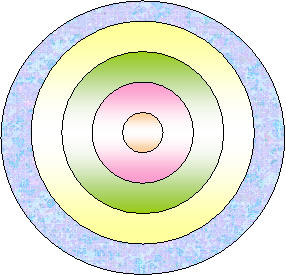The Five Tantric Bodies
 One of the challenges of understanding Tantra is that it transcends the focus most Westerners have that claims Tantra is nothing but, as one author called it, “The Yoga of Sex.” In actuality, that would be like saying an automobile is nothing but “The Yoga of Hubcaps.” There is so much more! In fact, Tantra is a complete ancient spiritual system, and most of the mystical (and practical) spirituality that comes from India and nearby areas can be traced directly to the ancient Tantrics.
One of the challenges of understanding Tantra is that it transcends the focus most Westerners have that claims Tantra is nothing but, as one author called it, “The Yoga of Sex.” In actuality, that would be like saying an automobile is nothing but “The Yoga of Hubcaps.” There is so much more! In fact, Tantra is a complete ancient spiritual system, and most of the mystical (and practical) spirituality that comes from India and nearby areas can be traced directly to the ancient Tantrics.
The practice known as yoga (or more accurate, hatha yoga) originated with the Tantrics. Recently, one yoga instructor allegedly used this information (somehow combined with Wicca!) to take advantage of some followers. Of course, abuse by self-styled spiritual leaders isn’t limited to any spiritual or professional area (see the book Sex in the Forbidden Zone by Peter Rutter). The solution, in my opinion, is in making the full knowledge of Tantra available to anyone. In the spirit of this idea I’d like to discuss the Tantric concept of the five bodies.
Atman
Imagine, if you will, a brilliant lightbulb representing your higher self. In Sanskrit, this higher self, the source of the stuff of which your soul is made, is called the Atman (aht-mahn). Although we may not recognize it, the Atman is always united with the Divine, the ultimate source of all, known as Brahman (brah-mahn or brach-mahn, not to be confused with Brahma, the Hindu god of creation).
The Body of Bliss
The first manifestation of the Atman is the body known as the Anandamaya Kosha (uh-nahn-duh-mai-yuh koh-sha). This is the level of what has been called “God Consciousness.” The term is generally translated as the “sheath of bliss.” It is that part of us that evolves through evolution and reincarnation, leading us to experience unity with the Divine. When you function from within this sheath or body, you are constantly in a state of bliss, having no attachments to any objects or desires.
Even though this perfectly blissful state is where we’re entitled to be, few people are there. That’s why it is viewed as a sheath or covering. It is actually separated from the Divine as a result of our focus on desires and self as separate from everything else. Although this is the highest level we can achieve before becoming one with the Divine, it is still separated from the Divine. It’s as if we have placed a lampshade around the lamp, dimming the light of the Divine. At best, it is but a dim reflection of the Atman. We may experience this body during trance and dreams, but we don’t usually experience it during our wakeful hours. The anandamaya kosha is associated with the use of the life force energy.
The Body of the Intellect
The second body is called the Vijnanamaya Kosha (veen-yah-nuh-mai-yuh koh-sha). It is the intellectual or knowledge sheath. It is less close to the Atman, but is still very etherial. Even so, it combines our intellect with the five sense organs. It identifies “us” with our physical body. If, with our intellect, we are able to see through the lampshade of what most people consider physical reality, it can lead to the serenity and spiritual bliss of the first body.
The two major functions of the vijnanamaya kosha, functions we can tap into at any time, are discrimination (the ability to tell the difference between relative truth and absolute truth), and non-attachment. Non-attachment does not mean being cold or reserved or trying to escape from the world. Rather, if means that we embrace the universe as it truly is, manifestations of spirit; all is Divine. We can work with this energy, but we cannot own it. Understanding this leads to living in the world, loving what we have access to, striving to increase access when desired, but realizing we cannot permanently possess or own energy. Therefore, there is no reason to be attached to it.
Again, this body is like another lampshade added, taking us further from our highest self. The vijnanamaya kosha is associated with the functions of the mind. Note that the mind is not the brain. The brain is a physical organ while the mind is non-physical.
The Body of Mind
The third body is called the Manomaya Kosha (mahn-oh-mai-yuh koh-sha) or the mental or mind sheath. It is the source of rational, sequential thought and the ability to discriminate after you have knowledge of something: the removal of ignorance. There are various yoga practices that have the goal of controlling the senses. Doing this will allow you to discover the nature of this body.
This is also the body that “houses” the subconscious, including memory, rationality, dreaming, and experiences of pleasure or pain as a result of our reactions to our actions in the past. Here are our fantasies and desires, our joys and hopes, our jealousies, angers, and sorrows. The manomaya kosha is associated with the nervous system.
Note that this body and the previous one are both associated to what we commonly call the mind. The second body deals more with inner aspects, such as the intellect and inductive reasoning, neither of which require external input or verification. The third body deals more with the way the mind deals with the exterior world and its own subconscious.
The Energy Body
So far, then, we have our higher self, our intellect, and our mind including the subconscious. Something has to supply energy for all of this, and that comes in the next body, the Pranamaya Kosha (Prawn-yah-mai-yuh koh-sha). It’s the sheath or body which is vitalized through breath, and which energizes all of the other koshas. Note that because of the importance of the breath, some people believe that the energy is actually in the air. This is not accurate. Breath and breathwork trigger the movement of the energy which flows through channels known as nadis (nah-dees).
The three most famous, and most important, of the nadis, are the Sushumna (soo-shoom-nuh), Ida (eee-dah), and Pingala (ping-uh-luh), which go through the center of the spine and on either side. The seven famous chakras are vortices, whorls of energy that are connected to these nadis and send energy through the five bodies. That is why the major chakras are so important. The pranamaya kosha is associated with the respiratory system, the circulatory system, and the endocrine system.
The Physical Body
This vitalized sheath operates with the body furthest from the Atman known as the Annamaya Kosha (ahn-uh-mai-yuh kosha) or physical sheath. Technically, the name indicates that this is the sheath of food, as food is necessary for the physical body to exist. When we look at the physical body, we often see separate systems that control all of the body functions. From a Tantric viewpoint, these functions are the result of the interaction of energy and consciousness.
Some spiritual traditions downplay the importance of this fifth kosha. They say we are just souls temporary residing in bodies and that the goal is to die and go to heaven and live with God or we need to die and live repeatedly in a world of “suffering and pain” until we learn enough so we don’t have to reincarnate any more. Tantra takes the view that the physical body is every bit as valuable as the other bodies. It is through the physical body that we can experience life. And when we harmonize our bodies, instead of life being suffering, it becomes beautiful! The annamaya kosha is associated with the digestive system.
Of course, being the fifth “lampshade,” it is furthest from our highest self. But the goal, according to Tantra, is not to get rid of the lampshades, but to harmonize them and enable them to work together.
The Tantra-Kabalah Link
This completely corresponds to what Israel Regardie described in The Middle Pillar. He writes that the goal of the magician is to perfect the ego, not eliminate it.
Is it not curious, that the path of the Kabalistic magician is quite in alignment with Traditional Tantra? While mythically the Kabalah is infinitely old, it can really only be traced back to about the 1st century c.e. Of course, there were various predecessors that the Kabalah united. Was Traditional Tantra (which is older than Vedic Hinduism), a source of the Kabalah?
Although these five bodies are usually described as sheaths and shown as concentric but separate entities, like the circles at the top of this post, they actually constantly interpenetrate each other. The five bodies make up the miracle that is you and me.









I feel pretty confident that a lot of Indian mysticism was brought back by Alexander’s followers after their expedition there. It merged with Egyptian mysticism during the Ptolemaic period, and highly influenced both Kabballah and the Hellenic mystery cults.
I believe that both systems are pointing to the same truth. We can say that Indian Mysticism influenced Western Mystery Traditions or that both just happened to experience the same reality, it of course may bie a bit of both. In both systems if the practitioner gets to that vantage point of seeing his true nature or communes with HGA, than the truth is conveyed in the language that is available to them at the time. The difficulty I have with the conclusion that Western systems were influenced by Eastern systems is that it has a tendency to deny that people from Western traditions also experienced enlightenment and their system unfolded from there. Western mysticism has borrowed from the East just as the contemporary Eastern systems have borrowed from the West. The fact that both systems point to the truth is the most important thing. Take from them what you will in order to enhance your path.
By the way, I wanted to thank Mr. Kraig for such really awesome and thought out posts. I really do enjoy them. In light of this post on Tantra, I wonder if you might be able to do something on Crowley’s use of the Tao Te Ching in relation to the Kabbalah? That would be fascinating. It would be great to hear it from an authority like Mr. Kraig.
Thanks!